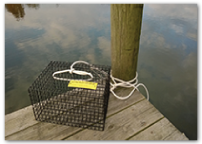You'll need:
- An existing pier or wharf with at least four feet of water at low tide located in one of the tributaries selected for the program, including creeks, coves and inlets in that tributary.
- The willingness to provide maintenance for up to four cages of oysters up to 10 months.
- An interest in the welfare of the Chesapeake Bay and becoming a Bay and oyster steward.
After I sign up, what can I expect to happen?
You will receive notification from the local sponsor (not DNR) that the cages containing up to 500 oyster spat per cage are ready for pickup in your local community. At the time of pickup you will receive a short briefing and information package on how to care for your oysters and then receive your oyster cages.
How big are the cages?

The cages are 18" long by 1 foot wide. They will weigh about 20 pounds when the oysters are grown after a year.
What do I do with the cages?
On the day you receive your cages, attach them to your pier or wharf (with the rope provided) so the cage hangs at least 6 inches off the bottom, away from sand and silt. The cage shouldn't touch the bottom. Also, the cage should be far enough below the water surface that in frigid winter weather the oysters are not exposed to the freezing air.
What type of maintenance is required?
While the cages and oysters are in your care very little maintenance is required. The main task is to keep them clean and, in the winter, keep them from freezing. Every two weeks, you should rinse your oysters by lifting the cage up and down out of the water to remove silt and sediment build up. "Dunk them like a tea bag". If needed, you can rinse them with a hose if you have one at your pier or you can scrub the cages with a brush and then rinse them by dunking them in the water. You don't need to scrub the shells or the oysters. The goal is to reduce fouling growth on the wire cage so water can flow through to the oysters and so the cage doesn't become too heavy due to the fouling growth.
During the winter, the oysters will die if exposed to freezing air temperatures; the oysters must be kept entirely in the water even on very low winter tides. Place the cages so they are just above the creek bottom to minimize the potential for freezing. In the spring, you can re-raise the cage.
What happens at the end of the growing period?
In about 9 months, you will be contacted and arrangements will be made for tributary representatives to collect your oysters for permanent placement on a sanctuary, an area closed to oyster harvesting. You will keep the cages to begin care-taking another group of spat.
What happens after the oysters are collected?
If you want to continue with the program you will receive new oyster spat. If you elect not to continue, your cages will be collected.
What happens if I have additional questions?
Should you have additional questions, the other sections of this website may provide the answers, or feel free to contact the Marylanders Grow Oysters Program manager, Eric Campbell, at [email protected].
Growing Oysters on Your Own?
If you are growing oysters on your own and aren't part of Marylanders Grow Oysters or another organized oyster growing group, such as the Chesapeake Bay Foundation, then please register your activity here.